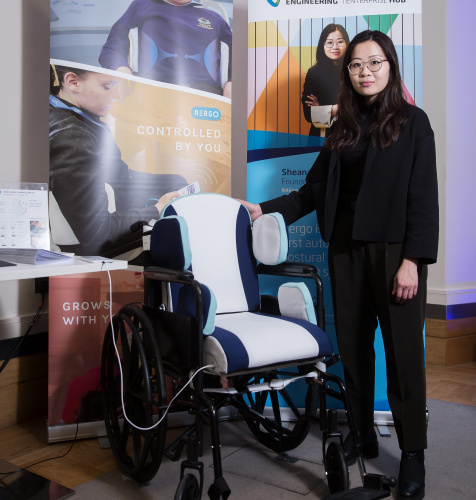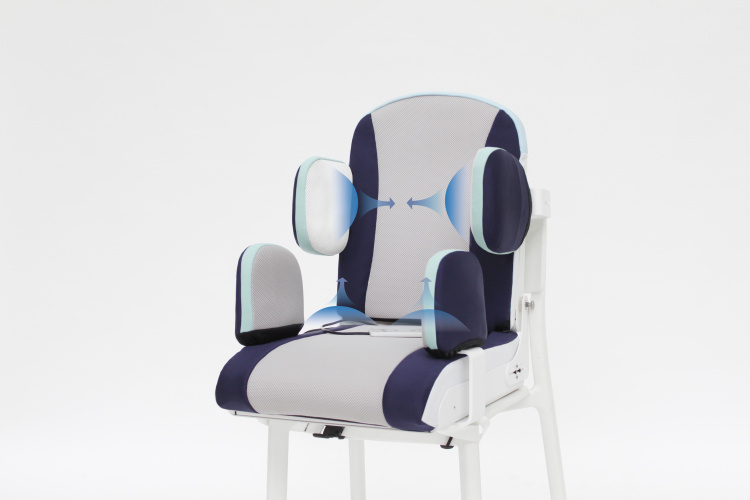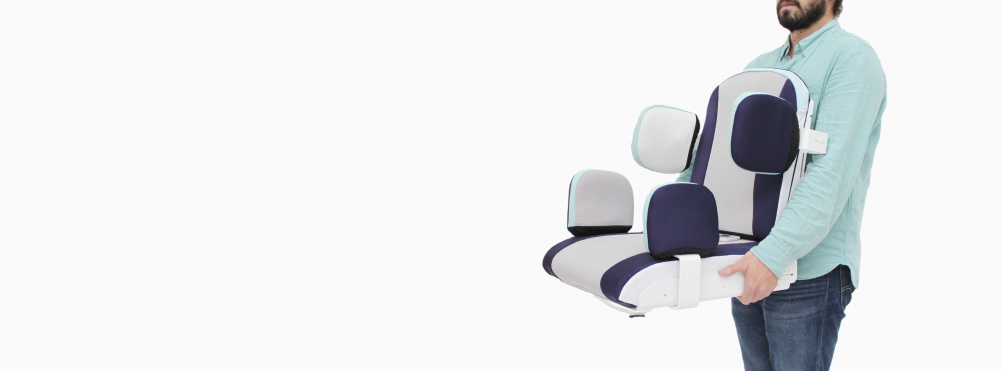
Life for disabled children and their families is difficult enough without having to contend with constant discomfort. Children with developmental and other disabilities depending upon wheelchairs or supports to help them sit upright face a number of difficulties: owing to lack of muscle tone and sometimes uncontrollable movement, they tend to slump into seating. Not only is this unpleasant, it can lead to organs becoming compressed, which, in turn, can lead to further developmental problems. Moreover, it can make communication – often affected by disability and tricky in any case – even more difficult.
_______________________________________________________________________
Further reading
- Interview: Ian Shott, chairman, Royal Academy of Engineering Enterprise Hub
- Engineer behind novel sepsis sensor takes RAEng prize
_______________________________________________________________________
All of these were problems which Hsin-Hia Yu - known as Sheana -faced while growing up. Suffering from scoliosis (curvature of the spine) following an accident as a child, she spent years in a wheelchair. “It’s affected me: the way I sit or the way I feel comfortable day to day,” she said. It was this experience that led to her interest in the social impact of engineering on individuals as she undertook her double Masters postgraduate degree in mechanical engineering and product design at Imperial College London and the Royal College of Art.

As part of this degree, Yu studied a module called Machines for Living, which involves designing for people with physical disability. Her project in this module was called Aergo, and involved designing a seat for wheelchair-using children with the sort of postural problems that had affected her as a child.
FIND OUT MORE ABOUT THE ROYAL ACADEMY'S ENTERPRISE FELLOWSHIP PROGRAMME
“I was working with a special needs school called Treloar in Hampshire," she said. "It’s a boarding school, and most children there have cerebral palsy. I realised that the pain I experienced as a child is even worse for them. They rely a lot on external equipment just to fix them in position. And because their posture is not aligned, they tend to slump in different directions. That’s not just painful; it means they can’t communicate smoothly, and they tend to get discriminated against even more because of the way they’re sitting. And that’s why, in relation to my own personal experiences, the pain I experienced from scoliosis growing up, and the social challenges these children face with disabilities, I wanted to come up with a better solution that would empower them not just physically, but also socially.”
The answer Yu came up with relies on inflatable air cells embedded in an adjustable child -sized wheelchair seat. These cells are connected to pressure sensors that continuously collect data as the child moves in the seat. “They calculate and monitor what is the pressure levels at different air cells to determine the user’s position, then inflate and deflate different pockets to reposition the user,” Yu explained. In the current version of the seat, six cells are positioned at various points: one in the lumbar region, two in the laterals, hugging the user just above the hips, two acting as pelvic support directly under the user, and one at the front of the seat to raise the knees.
Children find it hard to sit still at the best of times, and wheelchair users tend to wriggle out of the prescribed seating positions constantly. “The constant feedback the Aergo system receives from instances and the dynamic inflation and deflation of the air cells hugs them in a more comfortable scaffold system and prevents them from falling out of the optimum position for their development, communication and comfort.”
Children can always be depended upon to grow, and so Aergo has designed seats in four sizes, to accommodate users up to the age of 16. “We are trying to accommodate and have early intervention when the spine is still growing to make sure that before adulthood the user wouldn’t develop any more complications,” Yu explained.
"Over the past three years, we’ve built relationships with the market’s gatekeepers"
One of the guest lecturers at Imperial was Prof Sir Saeed Zahedi, a fellow of the Royal Academy of Engineering and technical director of prosthetic specialist Blatchford. “Zahedi came to Imperial to share the Blatchford portfolio of how it went about designing prosthetics and how it worked with amputees; he also talked about moving into the more speciality area of the market because it is looking at preventing pressure injuries. I re-approached Zahedi after I graduated, and he encouraged me to apply for the Enterprise Fellowship. He’s played a very important role since the very beginning of the Aergo journey,” said Yu.
The Royal College of Art provided the initial help for Yu to start a company, contributing seed funding, office space and business mentorship. Once her application for the Royal Academy of Engineering Enterprise Fellowship was successful, Zahedi became increasingly important, she explained. “Because I’m a sole founder, he’s helping me at a personal level in terms of leadership management and project planning. And that’s a big benefit to the business.

“On the other hand, he’s come to the office to discuss with the four members of the R&D team about how we should approach medical device regulation, what are the hurdles with my students, and what we need to start addressing now in terms of the design of the device. He’s very familiar with the industry, and that has been really helpful for my engineering lead to oversee the process in making sure that all the technical file product spec is compliant with the medical device standards.”
Yu and her team are currently preparing Aergo for a full commercial launch at the end of this year, to coincide with the Occupational Therapy Show at the National Exhibition Centre, but in the meantime, they have several trials in progress around the country. “We work with Alder Hey, which is an NHS children’s trust that operates around Liverpool. It’s played a critical role in advising us about the position of the air cells, how supportive they should be and how fast they should react, and it has also provided some of the users to test the device. Alder Hey told us that we shouldn’t approach the NHS directly as a purchaser, because it would insist on huge discounts and skew the margins. Unless you can produce in very large volumes it can make things difficult. Alder Hey’s advice was the private sector was a better target as we were starting out, and it put us in touch with its distributors and charities who help parents to buy equipment. Parents tend to be very savvy in looking for equipment for their children: they attend exhibitions and share information through online forums. Through that, our advertisements, and through charities tweeting about the device, we’ve had quite a lot of people approach us about testing the chairs.”
The medical devices market is a challenging one in which to launch a company, said Yu, which is why Zahedi’s mentorship was so valuable. “There are considerable barriers to entry. Our system is a combination of mechanical engineering, electronics, software, and a lot of design, even down to the upholstery, making sure that the fabric choices are also biocompatible to the user’s skin. There’s a level of development that went into making Aergo the safest and most robust it can be, because the target users are so fragile, and safeguarding children is a very high priority. There’s a lot of gatekeepers in the market. Over the last three years in parallel to development, we’ve established our network and built relationships with these gatekeepers and really, really got the word out there that we’re an inclusive company.”
Another possible market for Aergo’s technology is the ageing population. Older people who are confined to bed or wheelchairs are often highly susceptible to pressure sores, and the constant monitoring of sensors and dynamic adjustment of the air cells is an effective way to avoid this (similar technologies are used to prevent foot sores in diabetic people). Other applications for less medical markets are also possible. “We patented the air cells individually,” explained Yu. “They’re modular and can be integrated to a range of weight-supporting systems, because our goal is to evolve into a licensing model where we work with manufacturers in the beginning of the production of seating to have this air technology integrated, so that people or office workers who are quite prone to lower back pain could benefit from the technology. As well as pressure beds in hospitals, or car seats or airlines. In the future, we hope that we could make everyone more comfortable.”




Red Bull makes hydrogen fuel cell play with AVL
Formula 1 is an anachronistic anomaly where its only cutting edge is in engine development. The rules prohibit any real innovation and there would be...